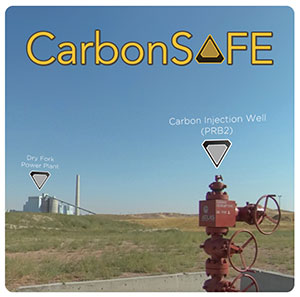UW’s 3D Visualization Center Develops Tool for Understanding Carbon Storage
Published April 05, 2024

The 3D Visualization Center at the University of Wyoming School of Energy Resources (SER) is developing a powerful outreach and communication application to help the public understand the mechanics of underground carbon storage as part of the Wyoming CarbonSAFE project in the Powder River Basin.
Located adjacent to Basin Electric Power Cooperative’s Dry Fork Station near Gillette, the Wyoming CarbonSAFE project is part of a national initiative to capture and permanently store large volumes of carbon dioxide deep underground.
The new interactive visualization tool developed by the 3D Visualization Center allows users to see and experience the sheer scale and depth of the project, as well as understand the different geological formations that serve as storage zones and caprock seals.
“We wanted to create something that allows users to experience what carbon capture and storage entail,” says 3D Visualization Center Manager Kyle Summerfield. “Tools like this go a long way in providing a basic understanding of a new technology and addressing concerns about the safety.”
Using 360-degree image capture, the application transports users on-site to the cap of a well drilled to over 2 miles below the surface. The well may someday be used for injecting carbon dioxide into the subsurface. Users can survey the entire area as well as see the proximity of Dry Fork Station. Through an interactive feature, the core of the geologic strata from the well rises from the ground in subsequent stages, using a school bus for scale. The user interface also includes a wealth of information about each geologic layer in a clean and unified format.
The interactive tool has been an effective way to help the audience understand how deep carbon dioxide would be injected and stored in the subsurface.
In addition to the subsurface depth and geologic information, the platform is a great visual for appreciating the small surface footprint of a project that houses such massive storage potential.
“We are so fortunate to have such an incredibly talented team of developers in the 3D Visualization Center and such an effective resource to help our outreach and communication efforts for these projects,” says SER Senior Director of Research Scott Quillinan. “It is difficult to really conceptualize the depth of storage formations, the density of the caprock seals and the distance from underground aquifers. We are so excited to hopefully expand these capabilities in the 3D Visualization Center and enhance other projects at SER.”
While the application is still being developed and refined, a demonstration can be navigated to on the Wyoming CarbonSAFE Project webpage at www.uwyo.edu/cegr/research-projects/wyoming-carbonsafe.html.
It eventually will be available for download for a variety of platforms and has been fine-tuned to run seamlessly on mobile, web, desktop and virtual reality platforms. The team will continue to add modules to the interactive tool as they are developed.
For more information on the 3D Visualization Center, visit www.uwyo.edu/ser.

